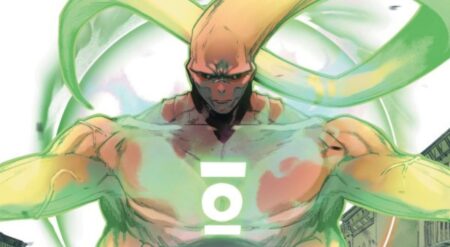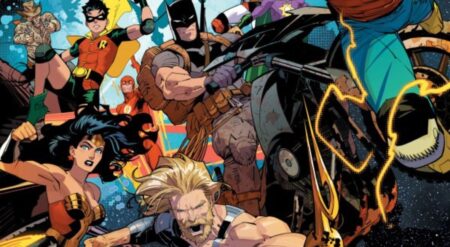
Justice League #68 is published by DC Comics. Written by Brian Michael Bendis with art by Scott Godlewski. The colourist is Gabe Altaeb and the letterer is Josh Reed. There is a backup story featuring the Justice League Dark. Written by Ram V, with art by Sumit Kumar and Nick Filardi on colours. Letters by Rob Leigh.
The Justice League has added some new members to its ranks. The young, new hero Naomi from another universe. The ancient, angry Black Adam. And Hippolyta, Queen of Themyscira. They were attacked by an alien creature designed to be the Superman on his planet. The alien had escaped the custody of the United Planets and destroyed the Hall of Justice. The League was forced to put a full call out, the entire reserve members and the United Planets joining the battle. To end the fight, Superman trapped the beast in the Phantom Zone. That conflict is over, but now the United Planets want the Phantom Zone Projector.
In this issue, the Justice League may have found themselves in another battle. Hawkslayer, the figurehead of the cosmic team, seems angry and determined to get the projector. But the League itself is also tired and not willing to bow down. After this showdown, there is the small manner of Black Canary discovering Green Arrow’s involvement in the secretive Checkmate.
The story of Justice League #68 would be better described as two stories (three, with the backup tale). The first half of the issue is dealing with the aftermath of the large battle the League and its allies have just finished with. A great feature of Bendis’ writing is consequences. The fight needs wrapping up and the characters are pent up from the fight, leading to a confrontation. After this, the book switches every part of the plot towards the Checkmate storyline. The pace may be exciting for some readers, but for others, the sudden change happens at a speed so fast it may cause whiplash if they aren’t careful. This plotline is difficult to follow, even if you follow other relevant series.
An aggravating factor of Bendis’s run so far is that he is connecting Justice League to so many other series, appearing to expect the reader to be following those as well. There are plausibly 3-4 other current books that seem to feed into what is happening. Having synergy between comics is a fantastic idea in concept, as is giving the Justice League a role in the stories, but the way the writer is constructing it is ultimately confusing and leads to the mind being frazzled. You can’t be surprised because not enough time is given to react to anything.
This is another issue with a huge cast. Three separate factions have a presence in this comic, with a potential for more. The Justice League have an expanded roster, the United Planets are on Earth and then many members of Checkmate appear as well. Bendis is equipped to deal with ensemble books, but there is an upper limit. Many characters are only here in a cameo role, and all have distinct voices boosted by Bendis’ sarcasm and wit. As the members of Checkmate watch someone fight, they analyse their moves and abilities in a very interesting piece of dialogue. But again, if the reader isn’t keeping track of other comics on the market, they may be left wondering who all of these people are.
The art is fantastic. Even with the enormous amount of figures to draw, Godlewski tackles them superbly. Each one seems like they are approached with a different design entirely, so they don’t look alike. Every alien, hero, and villain has a distinct shape, from their metal helmets down to their jawline. Justice League #68 is another action-packed issue, leading to some brilliant moments of excitement and tension that the artist heightens. The emotions on the characters’ aces are very clear and dynamic, from shock down to overbearing stress.
The colours are also incredibly good. Just as the story shifts, the tone of the colours alters as well. The cosmic story and the characters involved are full of vibrant, sometimes clashing tones as various races and costumes are stood right next to each other. But as the Schekmate part of the bok takes over, the shadows increase. The colours on superhero uniforms are still bright, but there are also more leather jackets and suits that don’t need brilliant yellows and reds.
The lettering is crucial in a book full of characters such as this. Despite a large amount of dialogue. Reed ensures it is easy to tell who is speaking at all times, with the text easy to read. There is a funny joke t one point that actually involves the sound that something makes, which is a clever piece of breaking the fourth wall.
In the backup story, The Justice League Dark’s fight with Merlin is reaching its conclusion. This is another ensemble cast that V manipulates superbly. With a very limited amount of space, the story is riveting and has many powerful twists within such a small amount of time. The team-up with Aquaman adds a different layer to the mystical combat. Kumar has a mesmerising ability to alter their art style to change the panel completely. With so many different types of powers and spells involved, this display of talent is jaw-dropping. The colours are stunning and also change with the varying styles.
Justice League #68 is a chaotic mess. There is a collection of brilliant ideas and a horde of excellent, beloved characters, with some dialogue that can be fun. It should be noted that an all-encompassing story across multiple books is not inherently wrong, and can be excellent if necessary. But Bendis is doing more than one of these in the same book and is going far too fast with it. It is detracting from what was initially a promising start for this new team. To go from a cosmic genre straight into a spy thriller in the same comic, without warning is too jarring for the reader. And this story can’t be full-sized because the Justice League Dark story, great as it is, takes up page space.
Justice League #68 is available where comics are sold.
Justice League #68
TL;DR
Justice League #68 is a chaotic mess. There is a collection of brilliant ideas and a horde of excellent, beloved characters, with some dialogue that can be fun. It should be noted that an all-encompassing story across multiple books is not inherently wrong, and can be excellent if necessary. But Bendis is doing more than one of these in the same book and is going far too fast with it. It is detracting from what was initially a promising start for this new team. To go from a cosmic genre straight into a spy thriller in the same comic, without warning is too jarring for the reader. And this story can’t be full-sized because the Justice League Dark story, great as it is, takes up page space.






